Full Text Searchable PDF User Manual
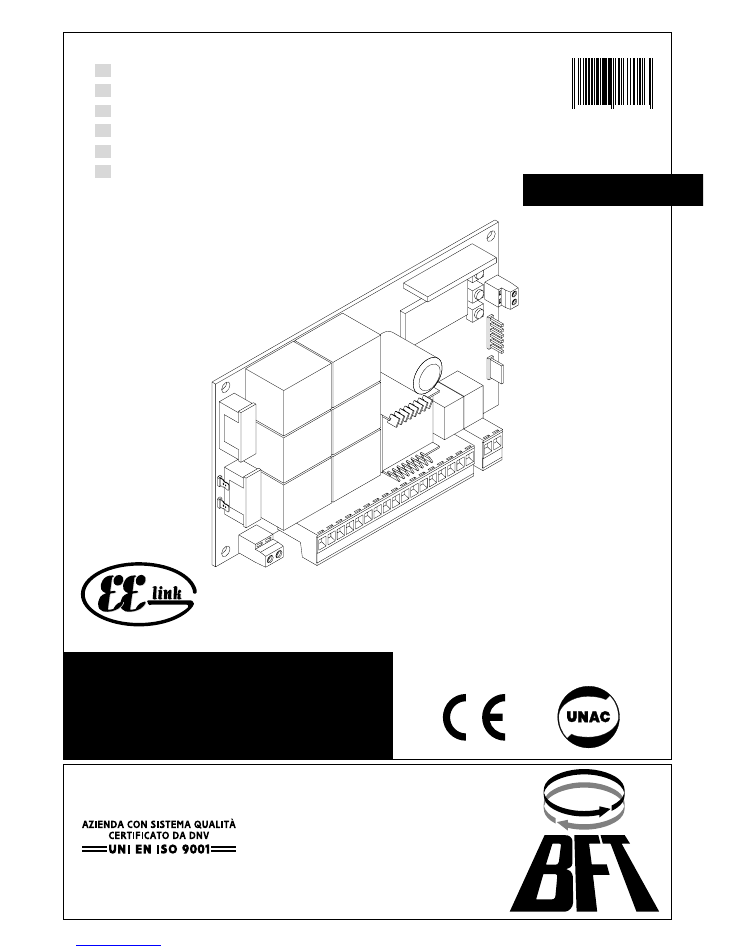
ISTRUZIONI D'USO E DI INSTALLAZIONE
INSTALLATION AND USER'S MANUAL
INSTRUCTIONS D'UTILISATION ET D'INSTALLATION
INSTALLATIONS-UND GEBRAUCHSANLEITUNG
INSTRUCCIONES DE USO Y DE INSTALACION
INSTRUÇÕES DE USO E DE INSTALAÇÃO
D811323 ver. 06 21-10-02
I
GB
F
D
E
P
QUADRO COMANDO
CONTROL PANEL
CENTRALE DE COMMANDE
STEUERUNG
CUADRO DE MANDOS
QUADRO DE COMANDO
LIBRA
88
88
Via Lago di Vico, 44
36015 Schio (VI)
Tel.naz. 0445 696511
Tel.int. +39 0445 696533
Fax 0445 696522
Internet: www.bft.it
E-mail: sales@bft.it
8
0 2 7 9 0 8 1 8 7 0 9 3

LIBRA - Ver. 06 -
11
D811323_06
INSTALLATION MANUAL
ENGLISH
Thank you for buying this product, our company is sure that you will be more
than satisfied with its performance.
This product is supplied with an “Instruction Manual” which should be read
carefully as it provides important information about safety, installation,
operation and maintenance.
This product complies with recognised technical standards and safety
regulations. We declare that it is in conformity with the following European
Directives: 89/336/EEC, 73/23/EEC, 98/37/EEC and subsequent amendments.
1) GENERAL SAFETY
WARNING! An incorrect installation or improper use of the product
can cause damage to persons, animals or things.
•
The “
Warnings
” leaflet and “
Instruction booklet
” supplied with this
product should be read carefully as they provide important information
about safety, installation, use and maintenance.
•
Scrap packing materials (plastic, cardboard, polystyrene etc) according
to the provisions set out by current standards. Keep nylon or polystyrene
bags out of children’s reach.
•
Keep the instructions together with the technical brochure for future
reference.
•
This product was exclusively designed and manufactured for the use
specified in the present documentation. Any other use not specified in
this documentation could damage the product and be dangerous.
•
The Company declines all responsibility for any consequences resulting
from improper use of the product, or use which is different from that
expected and specified in the present documentation.
•
Do not install the product in explosive atmosphere.
•
The construction components of this product must comply with the
following European Directives: 89/336/CEE, 73/23/EEC, 98/37/EEC
and subsequent amendments. As for all non-EEC countries, the above-
mentioned standards as well as the current national standards should
be respected in order to achieve a good safety level.
•
The Company declines all responsibility for any consequences resulting
from failure to observe Good Technical Practice when constructing
closing structures (door, gates etc.), as well as from any deformation
which might occur during use.
•
The installation must comply with the provisions set out by the following
European Directives: 89/336/CEE, 73/23/EEC, 98/37/EEC and
subsequent amendments.
•
Disconnect the electrical power supply before carrying out any work on
the installation. Also disconnect any buffer batteries, if fitted.
•
Fit an omnipolar or magnetothermal switch on the mains power supply,
having a contact opening distance equal to or greater than 3mm.
•
Check that a differential switch with a 0.03A threshold is fitted just before
the power supply mains.
•
Check that earthing is carried out correctly: connect all metal parts for
closure (doors, gates etc.) and all system components provided with an
earth terminal.
•
Fit all the safety devices (photocells, electric edges etc.) which are
needed to protect the area from any danger caused by squashing,
conveying and shearing.
•
Position at least one luminous signal indication device (blinker) where
it can be easily seen, and fix a Warning sign to the structure.
•
The Company declines all responsibility with respect to the automation
safety and correct operation when other manufacturers’ components
are used.
•
Only use original parts for any maintenance or repair operation.
•
Do not modify the automation components, unless explicitly authorised
by the company.
•
Instruct the product user about the control systems provided and the
manual opening operation in case of emergency.
•
Do not allow persons or children to remain in the automation
operation area.
•
Keep radio control or other control devices out of children’s reach, in
order to avoid unintentional automation activation.
•
The user must avoid any attempt to carry out work or repair on the
automation system, and always request the assistance of qualified
personnel.
•
Anything which is not expressly provided for in the present instructions,
is not allowed.
2) GENERAL OUTLINE
The LIBRA control panel is supplied by the manufacturer with standard
setting. Any alteration must be set by means of the incorporated display
programmer or by means of UNIPRO. The Control unit completely supports
the EELINK protocol.
Its main characteristics are:
-
Control of two low-voltage motors up to 40W power
-
Electronic torque setting with obstacle detection
-
Limit-switch control inputs
-
Separate inputs for safety devices
-
Incorporated radio receiver
The board is provided with a terminal board which can be pulled out for
easier maintenance or replacement. The board is supplied with a series of
pre-wired jumpers to facilitate the installer’s work.
The jumpers relate to the following terminals: 15-17 and 15-18. If the above-
mentioned terminals are in use, remove their respective jumpers.
3) TECHNICAL DATA
Power supply: ...................................................... ...230Va.c.
±
10% 50Hz*
Mains/low voltage insulation: ....................................... > 2MOhm 500Vdc
Dielectric strength:…. ............... mains/low voltage 3750Vac per 1 minute
Motor output current: ......................................................... 3.5A+3.5A max
Motor relay commutation current: ........................................................ 10A
Maximum motor power: ....................................................... 40W (24Vd.c.)
Supply to accessories: ......................... 24Va.c. (180mA max absorption)
24Va.c. V safe (180mA max absorption)
Gate-open warning light: ......................... N.O. contact (24Va.c./1A max)
Blinker: ........................................................................... 24Va.c. 25W max
Dimensions: ............................................................................. see figure 1
Fuses: ...................................................................................... see figure 2
(* other voltages available on request)
BATTERY KIT BT BAT (Fig.6)
Charging voltage: .......................................................................... 27.2Vdc
Charging current: ............................................................................ 130mA
Outside temperature when values were measured: .......................... 25
°
C
Battery capacity: ................................................................. 2x (12V 1.2Ah)
Flat battery protection threshold: ................................................ 20.4Vd.c.
Battery charging time: ................................................................. 12/14 hrs
4) TERMINAL BOARD CONNECTIONS (Fig.3)
WARNING
– During the wiring and installation operations, refer to the
current standards as well as principles of good technical practice.
Wires powered at different voltages must be physically separated, or
suitably insulated with at least 1 mm extra insulation. The wires must be
clamped by an extra fastener near the terminals, for example by bands.
All the connection cables must be kept at an adequate distance from the
dissipator.
WARNING! For connection to the mains, use a multipolar cable with
a minimum of 3x1.5mm
2
cross section and complying with the
previously mentioned regulations. For example, if the cable is out side
(in the open), it has to be at least equal to H07RN-F, but if it is on the
inside (or outside but placed in a plastic cable cannel) it has to be or
at least egual to H05VV-F with section 3x1.5mm
2
.
JP1
1-2
Single-phase mains power supply 230Va.c.
±
10% (1=L) (2=N)
JP9
3-4-5
Connection to motor 2:
3 motor + (red)
4 motor - (black),
5 limit-switch control (white)
6-7-8
Connection to motor 1:
6 motor + (red)
7 motor - (black)
8 limit-switch control (white)
9-10
Connection to blinker (24Va.c. 20W max)
JP8
11-12
Output 24Va.c. 180mA max - supply to photocells or other
devices
13-14
Output 24Va.c. V safe 180mA max - supply to photocell transmitters
with checking function (Fig.3a).
15-16
START pushbutton (N.O.).
15-17
STOP pushbutton (N.C.). If not used, leave the bridge 15-17
connected.
15-18
Photocell input (N.C.). If not used, leave the bridge 15-18
connected.
15-19
Fault input (N.O.). Input for photocells provided with checking
N.O. contact (Fig. 3a).
15-20
Pedestrian pushbutton input (N.O.). Activation is carried out by
motor 2; if the opening cycle has started (not from pedestrian
function), the pedestrian command has no effect.

12 -
LIBRA - Ver. 06
D811323_06
INSTALLATION MANUAL
ENGLISH
JP7
21-22
Output for gate-open warning light output (N.O. contact (24Va.c./
1A max)) or alternatively 2nd radio channel (see paragraph 5 on
“Configuration”)
23-24
Antenna input for radio-receiver plug-in board (23 braid–24
signal).
5) PROGRAMMING
The control panel provided with a microprocessor is supplied with function
parameters preset by the manufacturer, suitable for standard installations.
The predefined parameters can be altered by means of either the
incorporated display programmer or UNIPRO.
In the case where programming is carried out by means of UNIPRO,
carefully read the instructions relating to UNIPRO, and proceed in the
following way.
Connect the UNIPRO programmer to the control unit through the UNIFLAT
and UNIDA accessories (See fig. 4). The Libra control unit does not supply
the UNIPRO programmer with power, and therefore requires an appropriate
supply unit.
Enter the “CONTROL UNITS” menu, and the “PARAMETERS” submenu,
then scroll the display screenfuls using the up/down arrows to set the
numerical values of the parameters listed below.
For the function logics, refer to the “LOGIC” submenu.
In the case where programming is carried out by means of the incorporated
programmer, refer to Fig. A and B and to the paragraph on “Configuration”.
6) CONFIGURATION
The display programmer is used to set all the LIBRA control panel functions.
The programmer is provided with three pushbuttons for menu scrolling and
function parameter configuration:
+
menu scrolling/value increment key
-
menu scrolling/value reduction key
OK
Enter (confirm) key
The simultaneous pressure of the + and - keys is used to exit the active
menu and move to the preceding menu.
The modifications made are only set if the OK key is subsequently pressed.
When the OK key is pressed for the first time, the programming mode is
entered.
The following pieces of information appear on the display at first:
-
Control unit software version
-
Number of total manoeuvres carried out (the value is expressed in
thousands, therefore the display constantly shows 0000 during the first
thousand manoeuvres)
-
Number of manoeuvres carried out since the latest maintenance operation
(the value is expressed in thousands, therefore the display constantly
shows 0000 during the first thousand manoeuvres)
-
Number of memorised radio control devices.
When the OK key is pressed during the initial presentation phase, the first
menu can be accessed directly.
Here follows a list of the main menus and the respective submenus available.The
predefined parameter is shown between square brackets [ 0 ].
The writing appearing on the display is indicated between round brackets.
Refer to Figures A and B for the configuration procedure.
6.1) PARAMETER MENU (
PARAm
)
-
Automatic Closing Time (
TCA
) [ 10s ]
Set the numerical value of the automatic closing time from 3 to 60
seconds.
-
Motor 1 torque (
Mot1 torque
) [ 50% ]
Set the numerical value of the motor 1 torque between 1% and 99%.
-
Motor 2 torque (
Mot 2 torque
) [ 50% ]
Set the numerical value of the motor 2 torque between 1% and 99%.
NOTE: In case of obstacle detection, the Ampere-stop function
halts the leaf movement, reverses its motion for 1 sec. and then
halts in the STOP status.
WARNING: Check that the impact force value measured at the
points established by the EN 12445 standard is lower than that
specified in the EN 12453 standard.
Incorrect torque setting can cause injuries to persons or animals,
or damage to things.
-
Opening delay time (
open delay time
) [ 1s ]
Set the opening delay time for motor 1 relative to motor 2, between 1 and
5 seconds.
-
Closing delay time (
cls delay time
) [ 1s ]
Set the closing delay time for motor 2 relative to motor 1, between 1 and
5 seconds.
-
Zone (
zone
) [ 0 ]
Set the zone number between a minimum value of 0 and a maximum
value of 127. See paragraph 7 on “Serial connection”.
6.2) LOGIC MENU (
logic.
)
- TCA (
TCA
) [ OFF ]
ON
Activates automatic closing
OFF
Excludes automatic closing
- 3 Steps (
3 step
) [ OFF ]
ON
Enables 3-step logic. A Start impulse has the following effects:
door closed: ............................................................................ opens
on opening: ............................ stops and enters TCA (if configured)
door open: .............................................................................. closes
on closing: .......................................................... stops and reopens
OFF
Enables 4-step logic. A Start impulse has the following effects:
door closed: ............................................................................ opens
on opening: ............................ stops and enters TCA (if configured)
door open: .............................................................................. closes
on closing: ............................. stops and does not enter TCA (stop)
after stopping: ......................................................................... opens
-
Impulse lock (
ibl open
) [ OFF ]
ON
The Start impulse has no effect during the opening phase.
OFF
The Start impulse becomes effective during the opening or closing
phase.
-
Rapid closing (
fast cls
) [ OFF ]
ON
Closes the gate after photocell disengagement, before waiting for
the end of the TCA set.
OFF
Command not entered.
-
Photocells on opening (
photc. open
) [ OFF ]
ON:
In case of obscuring, this excludes photocell operation on opening.
During the closing phase, it immediately reverses the motion.
OFF: In case of obscuring, the photocells are active both on opening and
on closing. When a photocell is obscured on closing, it reverses the
motion only after the photocell is disengaged.
-
Photocell test (
test phot
) [ OFF ]
ON
Activates photocell check
OFF
Deactivates photocell check
If this setting is not activated (OFF), it inhibits the photocell checking
function, allowing connection of devices not provided with additional
checking contact.
-
Gate-open or 2nd radio channel warning light (
signaling outp
) [ OFF ]
ON
The output between terminals 21 and 22 is configured as Gate-open
warning light, in this case the 2nd radio channel controls pedestrian
opening.
OFF
The output between terminals 21 and 22 is configured as 2nd radio
channel.
- Motors in operation (
1 mot ON
) [ OFF ]
ON
Only motor 2 is in operation (terminals 3, 4 and 5).
With this configuration, the pedestrian input is disabled.
OFF
Both motors are in operation.
- Lock hold (
block persist
) [ OFF ] (Fig. 5)
ON
To be used when the mechanical closing backstop is fitted.
This function activates leaf pressure on the mechanical backstop,
without this being considered as an obstacle by the Ampere-stop
sensor.
Therefore the rod continues its travel for another 0.5 sec. after
detecting the closing limit switch or upon reaching the mechanical
backstop. So by activating the closing limit switches slightly earlier,
the leaves will come to a perfect halt against the backstop.
(Fig. 5a)
OFF
To be used when no mechanical closing backstop is fitted.
Movement is exclusively halted by activation of the closing limit
switches; in this case proceed to carrying out precise setting of the
closing limit-switch activation. (Fig. 5b)
- Master/Slave (
Master
) [ OFF ]
ON
The control panel is set as Master in a centralised connection (see
Paragraph 7).
OFF
The control panel is set as Slave in a centralised connection (see
Paragraph 7).
- Loop (
loop
) [ OFF ]
ON
In the case of a closed loop centralised connection (Fig.7), set the
control unit to ON.
OFF
In the case of an open centralised connection (Fig.7), set the control
unit to OFF.
6.3) RADIO MENU (
RADIO
)
-
Add
Allows you to add one key of a radio control device to the receiver
memory; after storage it displays a message showing the receiver
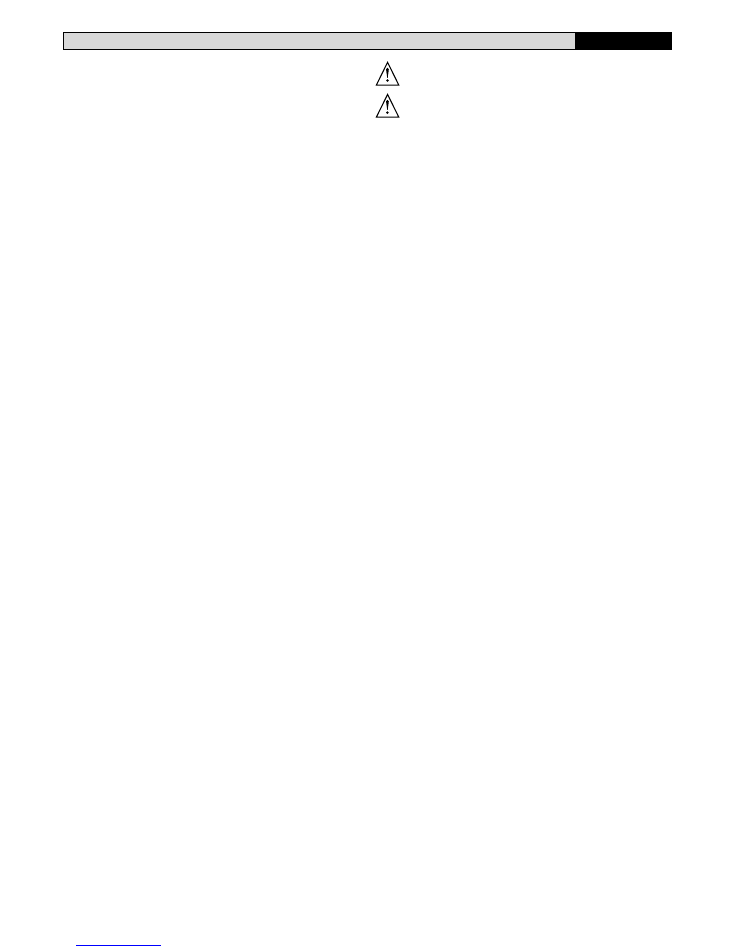
LIBRA - Ver. 06 -
13
D811323_06
INSTALLATION MANUAL
ENGLISH
number in the memory location (from 01 to 64).
Add Start button (
add start
)
associates the required key to Start command
Add 2ch button (
add 2ch
)
associates the required key to 2nd radio channel
-
Read (
read
)
Checks one key of a receiver; if stored it displays a message showing
the receiver number in the memory location (from 01 to 64), and the key
number (T1, T2, T3 or T4).
-
Delete (
erease 1
)
Removes one single key of a transmitter from the receiver memory; after
deletion it displays a message showing the receiver number in the
memory location (from 01 to 64).
-
Eliminate list (
erease 64
)
WARNING!
Completely removes all memorised radio control devices
from the receiver memory.
6.4) LANGUAGE MENU (
language
)
Allows you to set the language on the display programmer.
-
ITALIAN (
ITA
)
-
FRENCH (
FRA
)
-
GERMAN (
DEU
)
-
ENGLISH (
ENG
)
-
SPANISH (
ESP
)
6.5) DEFAULT MENU (
default
)
Restores the preset default values on the control unit. After restoring, a new
autoset operation must be carried out.
6.6) DIAGNOSTICS AND MONITORING
The display on the
LIBRA
panel shows some useful information, both
during normal operation and in the case of malfunctions.
Diagnostics:
In the case of malfunctions, the display shows a message indicating which
device needs to be checked:
STRT =
START
input activation
STOP =
STOP input activation
PHOT=
PHOT input activation
FLT
=
FAULT input activation for checked photocells
In the case where an obstacle is found, the LIBRA panel stops the door and
activates a reverse manoeuvre; at the same time the display shows the
“AMP” message.
Monitoring
:
During the opening and closing phases, the display shows four digits
separated by a dot, for example
35.40.
The digits are constantly updated
during the manoeuvre, and represent the maximum torque reached by
motor 1 (
35
) and motor 2 (
40
).
These values allow the torque setting to be corrected.
If the maximum torque value reached during the manoeuvre gets sensibly
close to the value set in the parameter menu, malfunctions may occur in the
future following wear or slight door deformation.
It is therefore advisable to check the maximum torque reached during some
of the manoeuvres carried out in the course of installation, and if necessary
set a value about 15-20 percent points higher in the parameter menu.
6.7) AUTOSET MENU (
autoset
)
Allows you to automatically set the Motor torque.
WARNING!!
The autoset operation is only to be carried out after checking
the exact leaf (opening/closing) movement, and correct limit-switch
activation.
As soon as the OK pushbutton is pressed, the “.... ....” message is
displayed, and the control unit executes an opening manoeuvre followed by
a closing manoeuvre, during which the minimum torque value needed for
leaf movement is automatically set.
During this phase, it is important to avoid obscuring the photocells, as well
as using the START, STOP or PED commands and the display.
After this, if autosetting has been successfully completed, the control unit
displays the “OK” message and, after pressing any key, returns to the
Autoset menu.
If, on the other hand, the control unit displays the “KO” message, it means
that the autoset procedure has not been successfully completed; it is thus
necessary to check the wear condition of the gate and the regular movement
of the leaves before proceeding to a new autoset operation.
WARNING! During the autoset phase, the obstacle detection function is not
active, therefore the installer must control the automation movement and
prevent persons and things from approaching or standing within the
automation working range.
In the case where buffer batteries are used, autosetting must be carried out
with the control panel supplied by mains power voltage.
WARNING: Check that the impact force value measured at the
points established by the EN 12445 standard is lower than that
specified in the EN 12453 standard.
Incorrect torque setting can cause injuries to persons or animals,
or damage to things.
6.8) Statistics
Having connected the UNIPRO programmer to the control unit, enter the
CONTROL UNIT / STATISTICS menu and scroll the screenful showing the
statistical parameters:
-
Board microprocessor software version.
-
Number of cycles carried out. If motors are replaced, count the number
of manoeuvres carried out up to that time.
-
Number of cycles carried out from the latest maintenance operation.
It is automatically set to zero after each self-diagnosis or parameter writing.
-
Date of latest maintenance operation. To be updated manually from the
appropriate menu “Update maintenance date”.
-
Installation description. 16 characters can be entered for installation
identification.
7) SERIAL CONNECTION USING SCS BOARD (Fig.7)
The
LIBRA
control panel allows several automation units (SCS) to be
connected in a centralised way by means of appropriate serial inputs and
outputs. This makes it possible to use one single command to open and
close all the automation units connected.
Following the diagram in Fig.7, proceed to connecting all the
LIBRA
control
panels, exclusively using a telephone-type line.
Should a telephone cable with more than one pair be needed, it is
indispensable to use wires from the same pair.
The length of the telephone cable between one appliance and the next must
not exceed 250 m.
At this point, each of the
LIBRA
control panels must be appropriately
configured, by setting a MASTER unit first of all, which will have control over
all the others, to be necessarily set as SLAVE (see logic menu).
Also set the Zone number (see parameter menu) between 0 and 127.
The zone number allows you to create groups of automation units,
each one answering to the Zone Master unit.
Each zone can only be
assigned one Master unit, the Master unit in zone 0 also controls the Slave
units in the other zones.
Loop closing of the serial connection (indicated by a dotted line in Fig.7) is
only needed if you require to check the no. of the connected devices by
means of UNIPRO.
8) SCRAPPING
Warning: This operation should only be carried out by qualified
personnel.
Materials must be disposed of in conformity with the current
regulations. In case of scrapping, the automation devices do not entail any
particular risks or danger. In case of materials to be recycled, these should be
sorted out by type (electrical components, copper, aluminium, plastic etc.).
9) DISMANTLING
Warning: This operation should only be carried out by qualified
personnel.
When the control unit is disassembled to be reassembled on
another site
,
proceed as follows:
•
Disconnect the power supply and the entire electrical installation.
•
In the case where some of the components cannot be removed or are
damaged, they must be replaced.
The descriptions and illustrations contained in the present manual
are not binding. The Company reserves the right to make any alterations
deemed appropriate for the technical, manufacturing and commercial
improvement of the product, while leaving the essential product
features unchanged, at any time and without undertaking to update
the present publication.
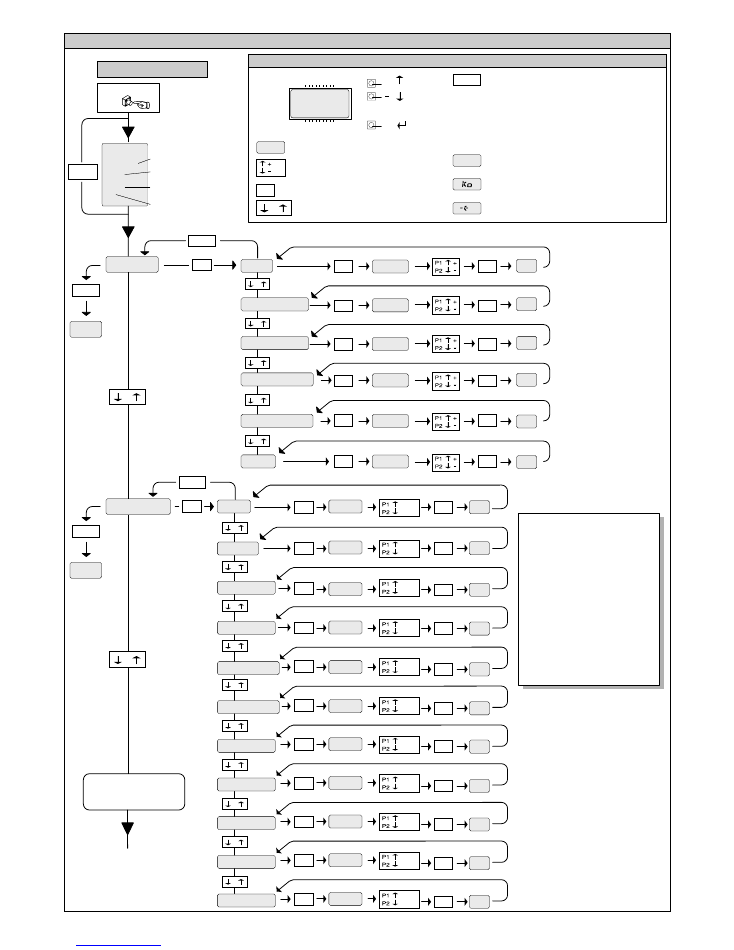
14 -
LIBRA - Ver. 06
D811323_06
+
OK
Fig. A
OK
Press the OK key
BFT
LIBRA1.0
0000
0000
00
PARAM
LOGIC.
OK
+
/
-
+
/
-
OK
ACCESS TO MENUS
FOLLOWING MENUS
FIG. B
OK
8 8 8 8
- +
- +
Control unit software version
No. total manoeuvres
(in thousands)
No. manoeuvres since latest
maintenance(in thousands)
No. radio control devices
memorised
LEGENDA
[
00
]
Preset value
Parameter increment/reduction
or ON/OFF commutation
Menu scrolling
(+ = preceding - = following)
Press OK key (Enter/confirm)
Message: Programming in progress
PRG
OK
+
/
-
- +
/ON
/OFF
Message: KO! (value or function error)
Simultaneously press the + and - keys.
Simultaneous pressure of the + and Ð keys
allows you to exit the active menu and return
to the preceding menu; if this takes place at
the main menu level, programming is exited
and the display switched off.
The modifications made are only confirmed if
the OK key is subsequently pressed.
+
/
-
END
+
/
-
END
Message: ÒWaitÓ (enter value or function)
OK
OK
TCA
[
0010
]
PRG
OK
OK
[
0050
]
PRG
Mot1 torque
OK
OK
[
0050
]
PRG
Mot2 torque
OK
OK
[
0010
]
PRG
open delay time
OK
OK
cls delay time
[
0010
]
PRG
- +
- +
- +
- +
- +
- +
- +
- +
- +
- +
- +
- +
- +
- +
- +
OK
OK
ZONE
[
0000
]
PRG
OK
TCA
ON
OFF
[
oFF
]
OK
PRG
OK
3 step
ON
OFF
[
off
]
OK
PRG
OK
ibl open
ON
OFF
[
off
]
OK
PRG
OK
fast cls
ON
OFF
[
off
]
OK
PRG
OK
Fotoc. open
ON
OFF
[
off
]
OK
PRG
OK
TEST PHOT
ON
OFF
[
off
]
OK
PRG
OK
signaling outp
ON
OFF
[
off
]
OK
PRG
OK
i Mot ON
ON
OFF
[
off
]
OK
PRG
OK
BLOC persit
ON
OFF
[
off
]
OK
PRG
OK
Master
ON
OFF
[
off
]
OK
PRG
OK
loop
ON
OFF
[
off
]
OK
PRG
PARAMETER MENU
TCA (automatic closing time)
value expressed in seconds
(default 10=10s, min 3=3s, max 60=60s)
Motor 1 torque value expressed in %
(default 50%, min 1%, max 99%)
Motor 2 torque value expressed in %
(default 50%, min 1%, max 99%)
Opening phase-difference Time
value expressed in tenths of a second
(default 10=1s, min 10=1s, max 50=5s)
Closing phase-difference Time
value expressed in tenths of a second
(default 10=1s, min 10=1s, max 50=5s)
Zone numerical value
(default 0, min 0, max 127)
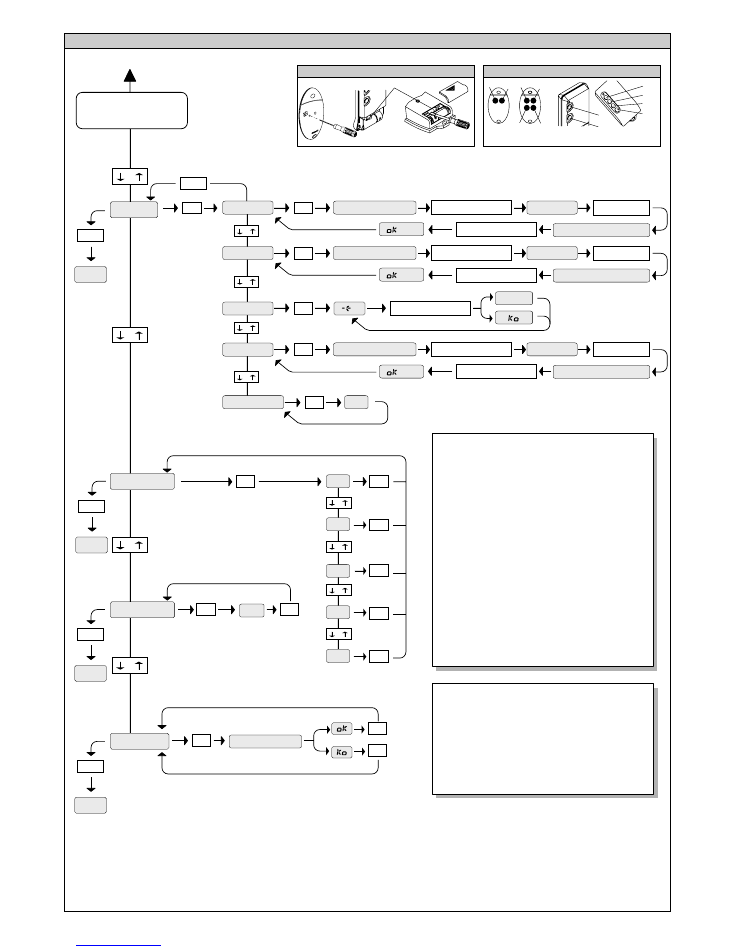
LIBRA - Ver. 06 -
15
D811323_06
Fig. B
DEFAULT
P1
T1
T2
T1
T2
T3
T4
TRC 1-2
TRC 4
FIG. 1A
FIG. 2A
TRC 1-2
TRC 4
MITTO 2-4
T1
T2 T1
T2
T3
T4
P1
RADIO
AUTOSET MENU
It automatically sets the motor torque.
WARNING! During the autoset phase, the obstacle
detection function is not active, therefore the installer
must control the automation movement and prevent
persons and things from approaching or standing
within the automation working range.
PRECEDING MENUS
FIG. A
OK
OK
- +
- +
- +
- +
+
/
-
END
+
/
-
END
Press P1 (pushbutton) on radio
control device Ð see Fig. 1A
Press the required T (key) on
radio control device Ð see Fig. 2A
Press the required T (key) on
radio control device Ð see Fig. 2A
Release P1 on radio
control device
ADD start
hidden button
release
desired button
01
erase 1
PRG.
READ
RADIO MENU
ADD - Allows you to add one key of a radio control
device to the receiver memory; after storage it displays
a message showing the receiver number in the
memory location (from 01 to 64).
Add Start button
Ð associates the required key to
Start command
Add 2ch button
Ð associates the required key to 2nd
radio channel
READ - Checks one key on a receiver, if stored it
displays a message showing the receiver number in
the memory location (from 01 to 64), and the key
number (T1, T2, T3 or T4).
ERASE 1 - Removes one single key of a transmitter
from the receiver memory; after deletion it displays a
message showing the receiver number in the memory
location (from 01 to 64).
ERASE 64
WARNING! Completely removes all memorised radio
control devices from the receiver memory.
01
OK
OK
OK
Press P1 (pushbutton) on radio
control device Ð see Fig. 1A
Press the required T (key) on
radio control device Ð see Fig. 2A
Release P1 on radio
control device
hidden button
release
desired button
OK
OK
+
/
-
ERASE 64
- +
- +
- +
Press P1 (pushbutton) on radio
control device Ð see Fig. 1A
Press the required T (key) on
radio control device Ð see Fig. 2A
Release P1 on radio
control device
ADD 2ch
hidden button
release
desired button
01
OK
- +
. . . . . .
OK
AUTOset
+
/
-
END
language
ITA
FRA
DEU
ENG
esp
OK
OK
OK
OK
OK
OK
+
/
-
END
- +
- +
- +
- +
OK
OK
01 t1
PRG
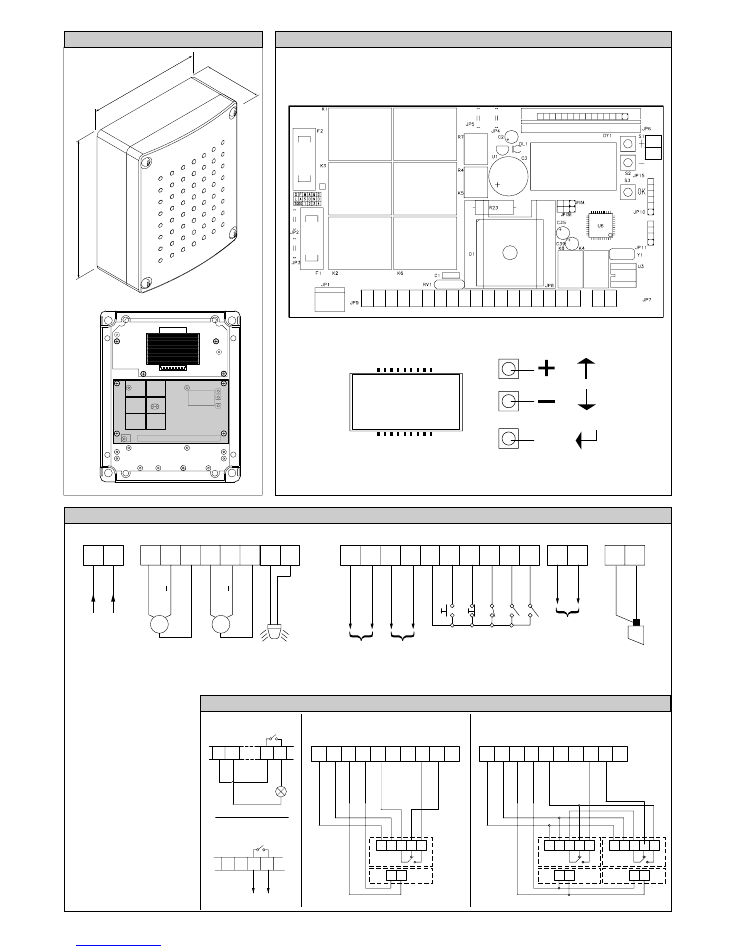
36 -
LIBRA - Ver. 06
D811323_06
Fig. 2
Fig. 3
Fig. 1
9 10
JP1
JP9
1
2
L
+
FC
N
3
4
5
6
7
8
M2
25
W
m
ax.
OK
8 8 8 8
1 2
23
6
194
100
LIBRA
SD
8 8 8 8
8 8 8 8
230V ~
+
FC
M1
3 4 5 6 7 8 9 10 11 12 13 14 15
17 18
16
19 20
21 22
23
24
Fig. 3a
JP8
11 12 13 14 15 16 17 18 19 20
C
O
M
P
H
O
T
FA
U
LT
24
V
~
24
V
~V
S
afe
Rx 1
Rx 2
Tx 1
Tx 2
1
2
3
4
5
1
2
1
2
1
2
3
4
5
JP8
11 12 13 14 15 16 17 18 19 20
C
O
M
P
H
O
T
FA
U
LT
24
V
~
24
V
~V
S
afe
Rx 1
Tx 1
1
2
3
4
5
1
2
F
1A
T
F
1A
F
JP9
M2
3
+
Rosso/Red/Rouges
Rot/Rojos/Vermelos
4
-
Nero/Black/Noir
Schwartz/Negro/Preto
5
FC Bianco/White/Blanc
Wei§e/Blanco/Branco
M1
6
+
Rosso/Red/Rouges
Rot/Rojos/Vermelos
7
-
Nero/Black/Noir
Schwartz/Negro/Preto
8
FC Bianco/White/Blanc
Wei§e/Blanco/Branco
JP8
JP7
11 12 13 14 15 16 17 18 19 20
S
TA
R
T
C
O
M
N
O
N
C
N
C
N
O
N
O
S
TO
P
ANT.
P
E
D
P
H
O
T
FA
U
LT
A
N
T
S
H
IE
LD
S
C
A
/II¡C
H
.R
21 22
23 24
24V ~
24V ~
VSafe
11 12
21
SCA
II¡ CH
22
19 20 21 22
24
V
~
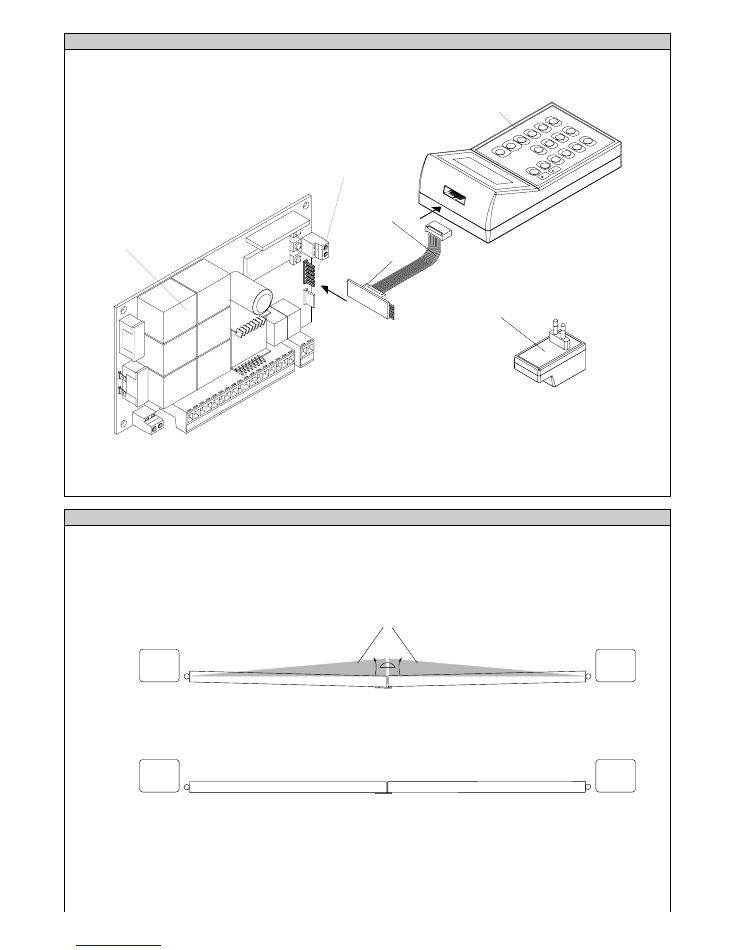
LIBRA - Ver. 06 -
37
D811323_06
Fig. 4
LIBRA
UNIPRO
Fig. 5
JP10
UNIDA
UNIFLAT
UNIPOWER
88
88
0,5s
A
B
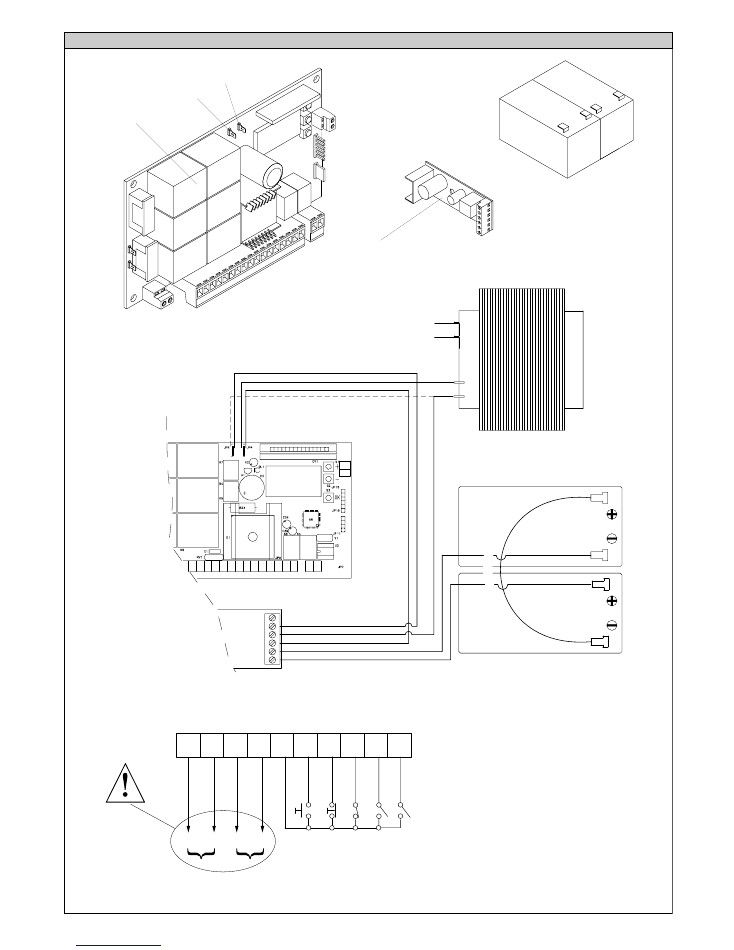
38 -
LIBRA - Ver. 06
D811323_06
Fig. 6
LIBRA
JP5
JP4
SBS
88
88
8 8 8 8
7 8 9 10 11 12 13 14 15
17 18
16
19 20
21 22
23
24
JP8
11 12 13 14 15 16 17 18 19 20
S
TA
R
T
C
O
M
N
O
N
C
N
C
N
O
N
O
S
TO
P
P
E
D
P
H
O
T
FA
U
LT
24V=
24V=
VSafe
SBS
LIBRA
33
33
55
230V
(*)
25V
44
33
(*) 110V
--
++
12V, 1.2 AH
12V, 1.2 AH
++
--
33
44
55
JP1
3
1
2
4
5
6
Ro
ss
o-
Re
d-
Ro
ug
e-
R
ot
-R
oj
o
Ve
rm
elh
o
+
+
-
-
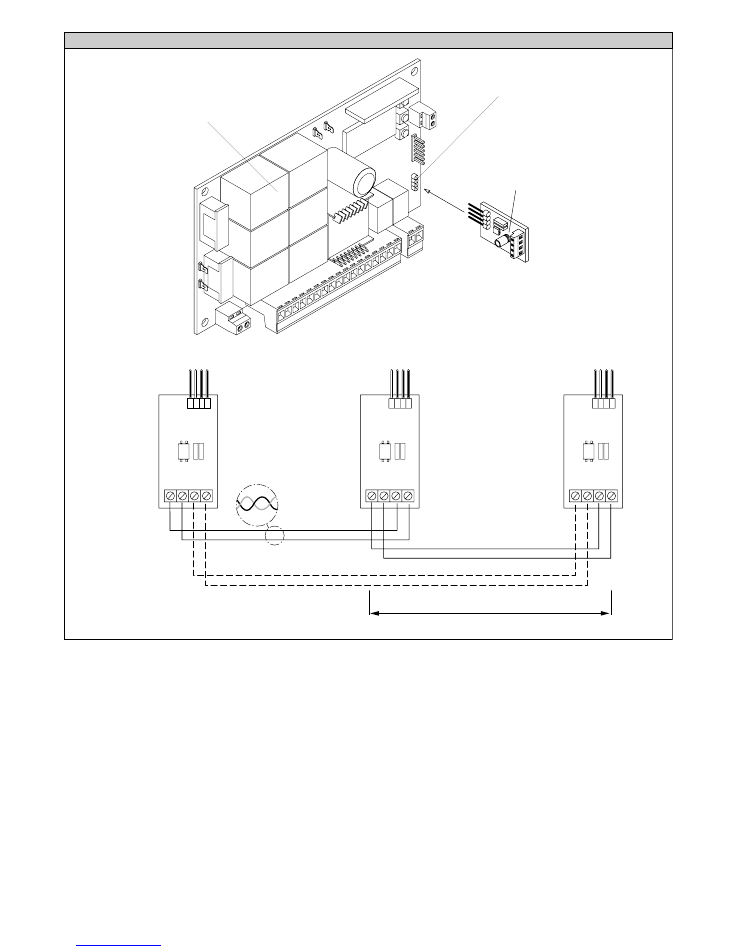
LIBRA - Ver. 06 -
39
D811323_06
Fig. 7
LIBRA
JP11
88
88
SCS
LIBRA/SCS1
LIBRA/SCS2
R
X
1
R
X
2
TX
1
TX
2
R
X
1
R
X
2
TX
1
TX
2
R
X
1
R
X
2
TX
1
TX
2
LIBRA/SCS2
Max. 250m